Correct use of a split system: operation of equipment + care tips
When purchasing an air conditioner, we must realize that without proper care this system will not last more than 2-3 years. But we want it to serve us long and effectively?
The only way to make this a reality is the correct use of the split system and regular maintenance of it.
Our article discusses the basic recommendations for operating air conditioners, rules and requirements, compliance with which will help you avoid mistakes and ensure a comfortable indoor microclimate.
The content of the article:
Split system device
To understand how to use a split system correctly, you first need to understand what it is, how best to choose the right model and where to place it.
A split system is one of the options for an air conditioner when it consists not of one unit (like a window or mobile unit), but of two - internal and external.
Of all the types of splits, wall splits are the most common and in demand. Other types, like columnar ones, cassette, channel And floor, are used several times less.
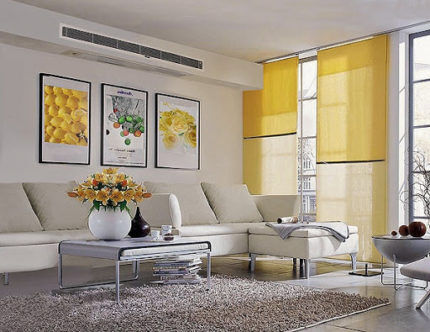
It would be a mistake to assume that fresh air enters and cools through the outdoor unit, and used air is pushed out. In fact, the same air circulates in the room.It is taken in through the indoor unit, cooled and returned back.
If you don’t delve into the process, the air conditioner works as a pump to pump/transport heat, thus, its excess is absorbed during the evaporation of freon in the indoor unit and transferred to the outdoor unit. In the case of heating mode, each block performs the opposite function.
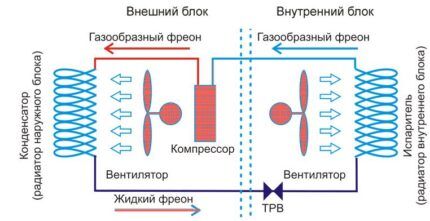
Each split system consists of two parts - outdoor and indoor units, which are connected by lines that include: a copper pipeline with freon, a condensate pipe and power cables.
Each unit has its own radiator, one fan, various filters, one common compressor and a valve in the outer part.
In a typical standard installation, the indoor unit is installed near the window, and the outdoor unit is installed outside under the window. At optimal length of the route between blocks no more than five meters, this placement is the most successful.
Installation of climate system
Correct installation of a split system is considered the key to successful operation of the equipment. During installation, each user will place the air conditioner in accordance with their own taste and room design, but several simple and necessary conditions will have to be met.
It is not recommended to place the system blocks on the south side, so as not to add pointless load to compressor.
If this cannot be avoided, the external unit can be protected with a visor, and the internal unit with curtains to prevent incorrect readings of temperature sensors.
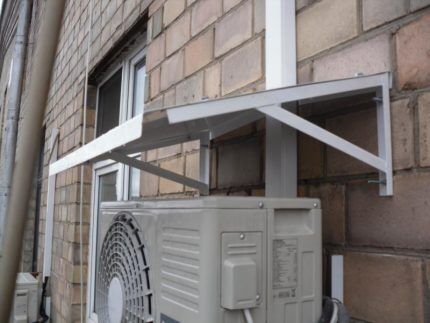
For the same reason, you cannot install the split system next to a heating device or electromagnetic radiation. When fastening, you should ensure that the equipment is positioned strictly horizontally, without distortion. Not to be confused with slope of the route for better condensate release.
Due to the fact that air enters the air conditioner from above, it is necessary to check the distance - at least 25 cm from the ceiling to the indoor unit. For effective operation, it is advisable not to place the system above cabinets and other furniture closer than 1 meter.
These recommendations will help you install the split system in the optimal location with unhindered and free circulation of air masses and the possibility of efficient use.
Determining the power of the air conditioner
All of the above will be relevant provided that the split system is selected correctly, since if the device is too weak or too strong, operation will be economically unprofitable.
Therefore, it is very important to correctly select a climate control equipment model based on the calculated power, i.e. determining how long it will take to cool a particular room to the desired temperature.
To determine the power of climate control equipment, a set of room parameters should be analyzed:
- area and height of the room;
- number of people;
- degree of sunlight;
- availability of heat-emitting household appliances.
The base is taken as the basic indicator of refrigeration capacity, calculated by dividing the area of the room by 10, thus we get the value for an empty room without equipment, objects and people.
The obtained value is adjusted depending on the number of residents or workers, the glass area and the amount of electrical equipment (heat flow from a person is 0.1-0.3 kW, from equipment 0.2-0.5 kW).
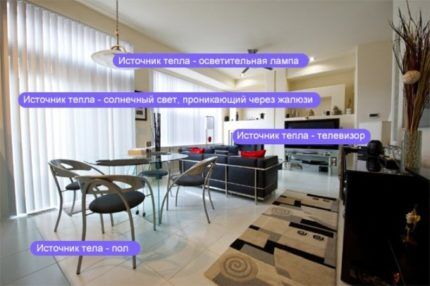
We add from 5% to 15% to the calculated value and get a power range that meets the requirements of our premises. Thanks to this calculation, we can confidently choose a high-quality split system that is ideally suited to the parameters of a particular room.
The cooling power of an air conditioner and the power consumption are different concepts. There is no point in trying to save money by deciding how many degrees to turn on the air conditioner to heat or cool the room. A split system is a fairly profitable technique; for one kilowatt of electricity consumed, it returns from 3 to 5 kW of cooled air.
Recommendations for using technology
After selecting and installing a split system, it is advisable to decide on the parameters for proper operation:
- Do not open windows when the device is turned on.
- Do not use critically low temperatures.
- Do not turn on the heating function when the outside temperature is below zero.
Ventilation is a necessary action when using a split system, since the device itself, by virtue of its design, cannot do this (with the exception of models with air supply).
However, the room should be ventilated only after turning off the units, so as not to load the unit.
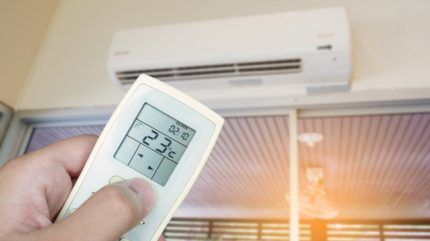
In the summer months, it is not recommended to set minimum values of 16-17 degrees, even in extreme heat; the optimal difference with external values is 5-10 degrees.
To ensure that the compressor does not wear out faster than expected and that the system components are not subjected to increased load when operating at maximum power, comfortable temperature values should be set from +20 to +27 degrees.
The longer the device operates, the better it cools the air. If the indoor unit of the system is exposed to direct sunlight, it is recommended to shade the device. For this purpose, you can cover the window with curtains or blinds.
Another situation is how to properly use an air conditioner for heating in the cold winter months, when at subzero temperatures the physical characteristics of the freon-oil mixture change?
After all, turning on equipment in cold weather can lead, if not to an immediate stop and drop in efficiency, then to freezing of the drainage pipe and blocks, and the risk of failure of the compressor and fan.
If there is a need to use air conditioning in frosty weather, you can purchase a special “winter kit”, the installation of which will protect your equipment from breakdowns.

However, split systems are designed for use at above-zero temperatures outside the window, therefore, it would be wise to use them for heating the room only in the fall before turning on the heating.
Tips for caring for a split system
In 75% of cases of serious malfunctions in the operation of climate control equipment, the cause is failure to follow simple basic rules of care and operation.
Here are some common tips on the dos and don'ts of any air conditioner model to achieve smooth and efficient operation.
As with any powerful electrical appliance, it is recommended to connect a separate power line with protection to the air conditioner from the electrical panel, and follow basic safety rules:
- Do not disassemble or repair the device yourself;
- in the event of a short circuit and malfunction, you must turn off the unit and call a technician;
- Do not touch the connected device with wet hands;
- If you need to disconnect the device from the network, you first need to stop its operation using the remote control, and only then unplug the cord from the outlet.
You can read more about how to properly connect an air conditioner to the network in this material.
In addition, it is strictly forbidden to allow children near a working air conditioner or to put objects into the grille of the split system.
In literate split system maintenance includes routine work that can be done independently, and more complex ones, the implementation of which is best entrusted to qualified craftsmen.
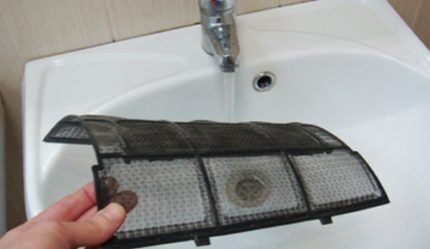
Cleaning the coarse filter is a fairly simple operation. Removing the plastic mesh and washing it with soapy water every two weeks is much easier than reaping the fruits of your laziness.
With poor quality or irregular cleaning, accumulated dust will lead to clogged filters and, as a result, obstructed air movement:
- the cooling rate drops;
- favorable conditions are created for the spread of microbes;
- electricity consumption and the amount in receipts increases;
- there is a danger of clogging the drainage system;
- there is a risk of compressor failure.
Cleaning the fan of the indoor and outdoor units and checking the freon level is, of course, carried out by a specialist, since this requires partial or complete disassembly. Also refilling with freon must be carried out by specialists.
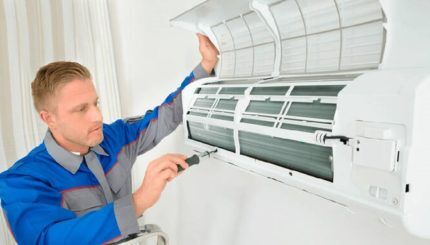
Thus, in order for the split system to delight you with long and uninterrupted operation, it is necessary to follow the recommendations of experienced professionals on the operation of air conditioners and their care.
And also: take seriously the choice of a device with a power suitable for the room, choose the right location for installation, choose the temperature regime wisely, carefully operate the device in winter and perform timely maintenance.
Conclusions and useful video on the topic
Installation of a “winter kit” by a master can be useful to every owner of a split system:
As you can see, in order for climate control equipment to work properly and last for many years, you should follow simple care recommendations and carry out regular maintenance. In addition, special attention should be paid to the correct installation of the air conditioner. The service life and uninterrupted operation of the equipment depend on it.
You can ask a question about the topic of the article or share valuable information related to the operation of climate control systems. Write your comments in the contact block below the article.



